Cervantes Saavedra Miguel de
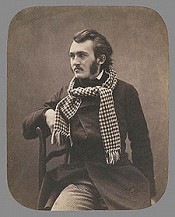
Paul Gustave Doré (French pronunciation: [pɔl ɡystav dɔʁe]; January 6, 1832 – January 23, 1883) was a French artist, engraver, illustrator and sculptor. Doré worked primarily with wood engraving and steel engraving. Doré was born in Strasbourg and his first illustrated story was published at the age of fifteen. At age five he was a prodigy artist already creating drawings. When he turned 12 he began to carve his art in stone. Doré began work as a literary illustrator in Paris. Doré commissions include works by Rabelais, Balzac, Milton and Dante. In 1853 Doré was asked to illustrate the works of Lord Byron. This commission was followed by additional work for British publishers, including a new illustrated English Bible. In 1863, Doré illustrated a French edition of Cervantes's Don Quixote, and his illustrations of the knight and his squire Sancho Panza have become so famous that they have influenced subsequent readers, artists, and stage and film directors' ideas of the physical "look" of the two characters. Doré also illustrated an oversized edition of Edgar Allan Poe's "The Raven", an endeavor that earned him 30,000 francs from publisher Harper & Brothers in 1883.[1] Doré's English Bible (1866) was a great success, and in 1867 Doré had a major exhibition of his work in London. This exhibition led to the foundation of the Doré Gallery in New Bond Street. In 1869, Blanchard Jerrold, the son of Douglas William Jerrold, suggested that they work together to produce a comprehensive portrait of London. Jerrold had gotten the idea from The Microcosm of London produced by Rudolph Ackermann, William Pyne, and Thomas Rowlandson in 1808. Doré signed a five-year project with the publishers Grant & Co that involved his staying in London for three months a year. He was paid the vast sum of £10,000 a year for his work. He was mainly known for his paintings, contrary to popular belief about his wood carvings. His paintings are world renowned, and his wood carvings are looked at as "mediocre."[citation please] The book, London: A Pilgrimage, with 180 engravings, was published in 1872. It enjoyed commercial success, but the work was disliked by many contemporary critics. Some critics were concerned with the fact that Doré appeared to focus on poverty that existed in London. Doré was accused by the Art Journal of "inventing rather than copying." The Westminster Review claimed that "Doré gives us sketches in which the commonest, the vulgarest external features are set down." The book was also a financial success, and Doré received commissions from other British publishers. Doré's later works included Coleridge's Rime of the Ancient Mariner, Milton's Paradise Lost, Tennyson's The Idylls of the King, The Works of Thomas Hood, and The Divine Comedy. His work also appeared in the Illustrated London News. Doré continued to illustrate books until his death in Paris in 1883. He is buried in the city's Père Lachaise Cemetery. Doré was a prolific artist; thus the following list of works, though extensive, is by no means comprehensive (e.g. it does not include his sculptures, paintings, nor many of his journal illustrations):
do you like this author?
What readers are saying
What do you think? Write your own comment on this book!
write a commentWhat readers are saying
What do you think? Write your own comment on this author!
write a commentBook list

Viage al ParnasoLa Numancia (Tragedia) y El Trato de Argel (Comedia)
Series:
Unknown
Year:
Unknown
Raiting:
4.5/5
Show more
add to favoritesadd In favorites
Book list

Viage al ParnasoLa Numancia (Tragedia) y El Trato de Argel (Comedia)
Series:
Unknown
Year:
Unknown
Raiting:
4.5/5
Show more
add to favoritesadd In favorites

Wit and Wisdom of Don Quixote
Series:
Unknown
Year:
Unknown
Raiting:
3.5/5
The most trivial act of the daily life of some men has a uniqueinterest, independent of idle curiosity, which dissatisfies us with themeagre food of date, place, and pedigree. So in the "Cartas de Indias"was published, two years ago, in Spain, a facsimile letter fromCervantes when tax-gatherer to Philip II., informing him of the efforts he had made to collect the taxes in certain Andalusian villages. --This text refers to the Kindle Edition edition.
Show more
add to favoritesadd In favorites
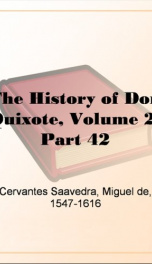
The History of Don Quixote, Volume 2, Part 42
Series:
Unknown
Year:
Unknown
Raiting:
4.5/5
This book was converted from its physical edition to the digital format by a community of volunteers. You may find it for free on the web. Purchase of the Kindle edition includes wireless delivery. HTML file
Show more
add to favoritesadd In favorites
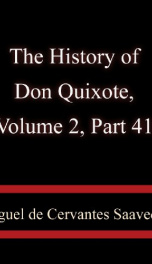
The History of Don Quixote, Volume 2, Part 41
Series:
Unknown
Year:
Unknown
Raiting:
3.5/5
This book was converted from its physical edition to the digital format by a community of volunteers. You may find it for free on the web. Purchase of the Kindle edition includes wireless delivery.
Show more
add to favoritesadd In favorites
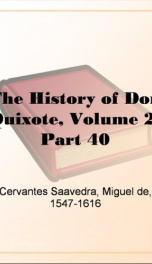
The History of Don Quixote, Volume 2, Part 40
Series:
Unknown
Year:
Unknown
Raiting:
0.5/5
This book was converted from its physical edition to the digital format by a community of volunteers. You may find it for free on the web. Purchase of the Kindle edition includes wireless delivery. HTML file
Show more
add to favoritesadd In favorites
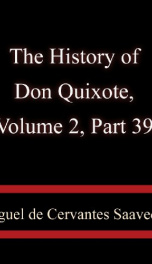
The History of Don Quixote, Volume 2, Part 39
Series:
Unknown
Year:
Unknown
Raiting:
3.5/5
This book was converted from its physical edition to the digital format by a community of volunteers. You may find it for free on the web. Purchase of the Kindle edition includes wireless delivery.
Show more
add to favoritesadd In favorites
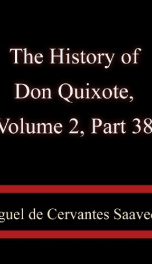
The History of Don Quixote, Volume 2, Part 38
Series:
Unknown
Year:
Unknown
Raiting:
3.5/5
This book was converted from its physical edition to the digital format by a community of volunteers. You may find it for free on the web. Purchase of the Kindle edition includes wireless delivery.
Show more
add to favoritesadd In favorites
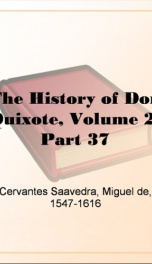
The History of Don Quixote, Volume 2, Part 37
Series:
Unknown
Year:
Unknown
Raiting:
0.5/5
This book was converted from its physical edition to the digital format by a community of volunteers. You may find it for free on the web. Purchase of the Kindle edition includes wireless delivery. HTML file
Show more
add to favoritesadd In favorites

The History of Don Quixote, Volume 2, Part 36
Series:
Unknown
Year:
Unknown
Raiting:
1/5
This book was converted from its physical edition to the digital format by a community of volunteers. You may find it for free on the web. Purchase of the Kindle edition includes wireless delivery. HTML file
Show more
add to favoritesadd In favorites
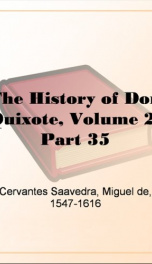
The History of Don Quixote, Volume 2, Part 35
Series:
Unknown
Year:
Unknown
Raiting:
1/5
The most famous work by Miguel de Cervantes Saavedra, a Spanish novelist, poet, and playwright. The seventeenth century “Don Quixote” is considered to be the first modern novel, and ranks with the best novels ever written. It combines amusement with the depth of thought and the strength of literary generalization. The novel describes the adventures of a ridiculous, eccentric, gaunt knight-errant astride his fallible steed, who lives in a world created in his imagination, cherishes the dream of his ideal woman, Dulcinea, and deals with windmills, bedclothes, and much disappointment. The book has always been the object of an argument – some considered Don Quixote to be just a ridiculous parody, the others saw the devotee, who embodied the human spiritual nobleness. Nevertheless, being one of the most beloved stories of European literature, “Don Quixote” has pro-vided readers throughout the centuries with humorous, yet poignant, chivalric tales. Every epoch revealed some new facets in the hero, and reconsidered the character, what breathed new life into the book. This volume contains chapters LVIII – LIX.
Show more
add to favoritesadd In favorites
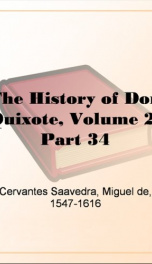
The History of Don Quixote, Volume 2, Part 34
Series:
Unknown
Year:
Unknown
Raiting:
1.5/5
“The adventures of Don Quixote” is the very book that made Cervantes famous. This book is another part of courageous Don Quixot’s adventures. Funny, cute, kind and brave hero will amaze readers once again.
Show more
add to favoritesadd In favorites
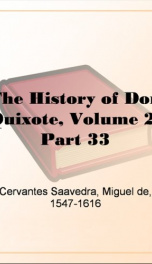
The History of Don Quixote, Volume 2, Part 33
Series:
Unknown
Year:
Unknown
Raiting:
3/5
This book was converted from its physical edition to the digital format by a community of volunteers. You may find it for free on the web. Purchase of the Kindle edition includes wireless delivery. HTML file
Show more
add to favoritesadd In favorites
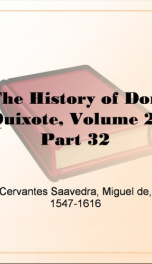
The History of Don Quixote, Volume 2, Part 32
Series:
Unknown
Year:
Unknown
Raiting:
4.5/5
This book was converted from its physical edition to the digital format by a community of volunteers. You may find it for free on the web. Purchase of the Kindle edition includes wireless delivery. HTML file
Show more
add to favoritesadd In favorites

The History of Don Quixote, Volume 2, Part 31
Series:
Unknown
Year:
Unknown
Raiting:
1/5
This book is the second volume, thirty first part of a famous series of stories devoted to Don Quixote. The story appeared for the first time at the beginning of the 17th century and was written by Miguel de Cervantes. The main character is a real gentleman and a big dreamer. He decides to leave his home village and travel around the world and perform heroic acts which he wants to dedicate to his beloved Dulcinea. Don Quixote travels on his horse with his faithful servant Sancho Panza. And on his way he gets into a number of adventures so be ready to dive into his adventures and laugh a lot.
Show more
add to favoritesadd In favorites
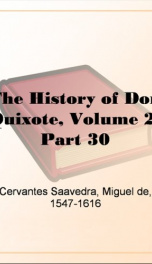
The History of Don Quixote, Volume 2, Part 30
Series:
Unknown
Year:
Unknown
Raiting:
4.5/5
This book was converted from its physical edition to the digital format by a community of volunteers. You may find it for free on the web. Purchase of the Kindle edition includes wireless delivery.
Show more
add to favoritesadd In favorites
What readers are saying
What do you think? Write your own comment on this author!
write a commentif you like Cervantes Saavedra Miguel de try:
readers also enjoyed
What readers are saying
What do you think? Write your own comment on this author!
write a commentGenre
if you like Cervantes Saavedra Miguel de try:
readers also enjoyed
Do you want to read a book that interests you? It’s EASY!
Create an account and send a request for reading to other users on the Webpage of the book!

